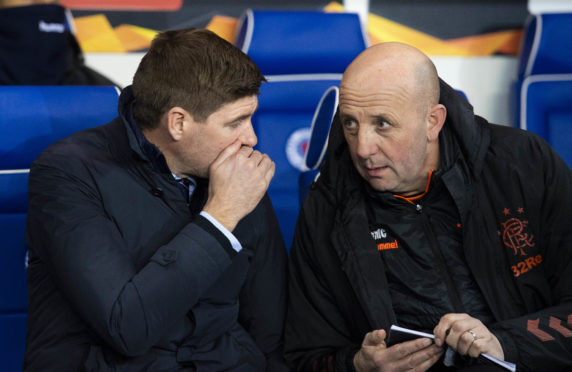
It’s not the way we would have wanted, but everyone in Scottish football now has time to reflect on recent events.
Rangers manager Steven Gerrard will have more than most to ponder as he awaits a return to competitive football at some time in the future.
The former England midfielder appeared as perplexed as everyone else by the way his side’s form collapsed since their return from the winter break.
You have to wonder if he spotted a little clue during Thursday night’s Europa League tie against Bayer Leverkusen.
Recent poor results have had supporters questioning if certain players are good enough to be part of a successful Rangers team.
Strength-in-depth is undoubtedly a problem with Gerrard’s squad.
His aim was to have two players for every position at the start of the campaign.
Rarely, however, have the squad men proved themselves to be worthy of a first-team shirt.
Fringe players like Jordan Jones, Brandon Barker, Jon Flanagan, Greg Stewart and Matt Polster have made little or no impact.
Others, like Glenn Middleton, Greg Docherty, Ross McCrorie and Jamie Murphy found themselves sent out on loan.
But Rangers can’t use the back-up boys as an excuse for the way their title challenge faded.
Insipid performances in the SPFL have been in stark contrast to the up-and-at-’em approach that took them to the last 16 in Europe.
It all suggests that Gerrard should be training his players’ minds as much as their bodies.
Two weeks ago, I asked him if getting the mentality right among a group of talented players was the essence of modern management.
He didn’t disagree with that assertion.
In fact, he readily agreed, saying: “You need players who have the right mentality, focus, standards and professionalism to go around the talent and that’s what we’re trying to get here – a group where everyone is on the same page and understands the challenge.”
I took from his answer that Gerrard has serious doubts about some of his players’ commitment to the cause.
They find the energy to fight tooth and nail against the likes of Feyenoord, Porto and Braga. But are less keen on battling with Kilmarnock, Livingston and Hamilton Accies.
That’s simply not good enough.
Showing the same vigour in bread-and-butter matches is fundamental to being a successful Old Firm player.
And that brings us back to a short episode that occurred during the defeat by Leverkusen.
Rangers won a free-kick just outside the penalty area in the 77th minute. Ianis Hagi grabbed the ball and was clearly keen to repeat the strike that hit the net against Braga last month.
A players’ debate ensued and was settled by captain James Tavernier deciding that Borna Barasic would take the kick.
Hagi clearly wasn’t amused. It looked like he was sulking.
He was snapped out of his mood by Alfredo Morelos imploring him to get his head up.
Morelos, who has looked to be lacking enthusiasm lately, should take his own advice – and he’s not the only one.
Getting that attitude game-in, game-out, is something Steven Gerrard has to aim for whenever football restarts.

Enjoy the convenience of having The Sunday Post delivered as a digital ePaper straight to your smartphone, tablet or computer.
Subscribe for only £5.49 a month and enjoy all the benefits of the printed paper as a digital replica.
Subscribe